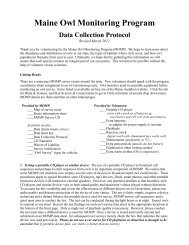Focus Species Forestry - Maine Audubon
Focus Species Forestry - Maine Audubon
Focus Species Forestry - Maine Audubon
Create successful ePaper yourself
Turn your PDF publications into a flip-book with our unique Google optimized e-Paper software.
Large Ownerships: On a typical township in the unorganized territories, Hunter’s rule<br />
would suggest that equal areas should be allocated to single tree and small group<br />
selection management (openings less than 0.25 acre), large group selection (0.25-2.5<br />
acres), patch cuts and small shelterwood cuts or clearcuts (2.5-25 acres) and large<br />
shelterwood cuts or clearcuts (25-250 acres). Within the shelterwood and clearcut<br />
categories, applying Hunter’s rule would suggest allocating equal areas to different<br />
opening sizes (e.g., the area in cuts from 25 to 75 acres should equal the area in patches<br />
from 75 to 250 acres).<br />
Small Ownerships: Create a diversity of<br />
opening sizes appropriate to the ownership.<br />
Hunter (1999) suggests that the same<br />
general allocation approach used for large<br />
ownerships can be used on small parcels,<br />
but the maximum size of even-aged units<br />
(shelterwood or clearcut) will be much<br />
smaller than on large tracts of commercial<br />
timberland.<br />
This approach to creating a diversity of patch sizes<br />
is probably best viewed as a conceptual model<br />
rather than a quantitative management<br />
prescription. It is a more aggressive approach to<br />
creating large patches than would occur under<br />
natural conditions, so should be used with caution.<br />
However, it is more conservative than much of the<br />
management seen today on industrial and investor<br />
timberlands. Individual stand conditions, landscape<br />
features, landowner objectives, and focus species<br />
habitat will take priority. Nonetheless Hunter’s<br />
rule provides a useful context for evaluating the<br />
diversity of patch sizes in the current landscape<br />
and how that diversity will be impacted by<br />
management prescriptions.<br />
Limit the Area in Single-Aged Stands<br />
If the harvests result in nearly complete overstory<br />
removal, the result will be a harvesting regime that<br />
is much more aggressive than that resulting from<br />
natural disturbance regimes. Even “stand-replacing<br />
disturbances” such as fire, wind, or spruce<br />
Habitat Management and the<br />
<strong>Maine</strong> Forest Practices Act<br />
<strong>Maine</strong>’s Forest Practices Act (FPA) limits the size<br />
of clearcuts and requires separation zones be<br />
retained that meet specified standards. Depending<br />
on the size of the clearcut, the separation zones can<br />
be harvested in approximately 10-15 years. Thus,<br />
clearcutting could be used to create large patches of<br />
early successional habitat consisting of a mosaic of<br />
stands that are separated by 10-15 years in age.<br />
Alternatively, under the FPA there is no limit on<br />
patch size that can be created with the shelterwood<br />
system. When even-aged management is used:<br />
• Whenever possible, use shelterwood harvesting<br />
instead of clearcutting.<br />
• Avoid a uniform application of similar-size<br />
harvest units evenly distributed across the<br />
landscape. See recommendations above on<br />
creating a balanced diversity of patch sizes,<br />
which will result in areas with high levels of<br />
habitat interspersion as well as a few large,<br />
relatively uniform patches.<br />
• Follow the stand-level guidelines for retaining<br />
snags, cavity trees, downed logs and patches of<br />
older forest in even-aged management areas.<br />
• Maintain travel corridors of mature forest in a<br />
landscape where shelterwood and clearcutting<br />
are used.<br />
• Maintain adequate mature forest at all times,<br />
including some areas that do not “shift” across<br />
the landscape (i.e., areas where single-tree<br />
selection, group selection, or two-aged<br />
management are used.<br />
budworm result in irregular two-aged stands. In a review of silviculture and natural disturbance<br />
regimes in <strong>Maine</strong>, Seymour et al. (2002) observe that an artificial landscape pattern exists when<br />
even-aged stands exceed 15-25% of the landscape. The shelterwood-with-reserves method (see<br />
68<br />
<strong>Focus</strong> <strong>Species</strong> <strong>Forestry</strong>



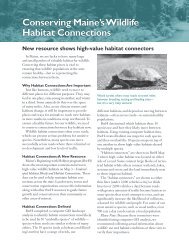
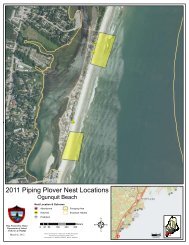
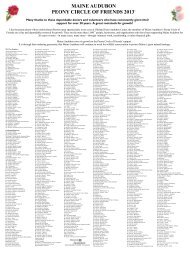
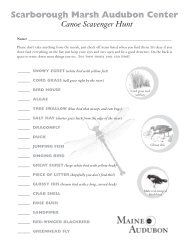


![2012 Loon Count Results [pdf] - Maine Audubon](https://img.yumpu.com/26228732/1/190x245/2012-loon-count-results-pdf-maine-audubon.jpg?quality=85)
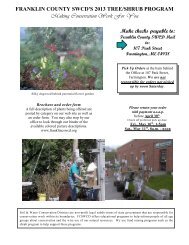

![Lake Fish of Maine (DIFW list) [pdf] - Maine Audubon](https://img.yumpu.com/23282964/1/190x245/lake-fish-of-maine-difw-list-pdf-maine-audubon.jpg?quality=85)
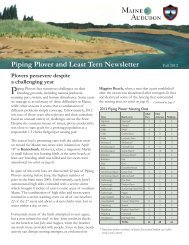

![The Maine Audubon Peony Circle of Friends 2012 [pdf]](https://img.yumpu.com/22707677/1/190x253/the-maine-audubon-peony-circle-of-friends-2012-pdf.jpg?quality=85)
